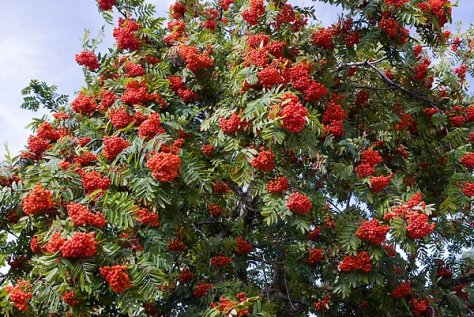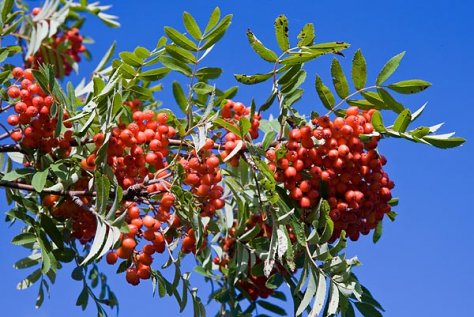Plenty of berries on rowans
Photos: Arne Ader
Translation: Liis
Rowan tree
Rowan; Mountain ash Harilik pihlakas Sorbus aucuparia
For botanists the truss of berries of the rowan is a corymb and the rowan’s berry is a pome. In fact when the little fruit, with a diameter of up to a centimetre, is cut into half it reminds of a miniature apple and the chemical composition is similar to that of apples. There are three seeds in the fruit.
Rowanberries become fully ripe with the first harder frosts because the taste of the berries changes to sweeter after a frost, the bitter taste decreases and the fruit becomes juicier.
What happened in the berries? Under the influence of frost, biochemical changes took place: by hydrolysis glucose and fructose were formed, starch was turned into sugars and there were changes in the pectin substances. The amount of soluble pectin increased and insoluble pectin decreased. The share of malic acid and tannins decreased.
An attentive observer will notice these quite important changes: only after frosts the rowanberries suddenly become attractive to feathered and furry creatures (brown bears as well as elks enjoy the fruits).
A hundred years ago rowanberries were still saved in bunches in hay barns, attics or granary sheds.
We pick the whole trusses together with any leaves that come along and place them for 24 hours in the freezer in order to prepare juice or syrup from them or leave them to be used raw. Rowanberries contain a large amount of vitamins and also vital substances for the organism.
The easiest way to use rowanberries: take 10 rowanberries with a spoonful of honey – the size of the spoon is one’s own decision. We recommend a soup spoon .
Rowan
This year there will be enough rowanberries for all. A deluge of berries marked a stormy autumn for people on the coasts. On the mainland plenty of rowanberries predicted a famine year or a snowy and long winter for people of old. Who lives, will see.










